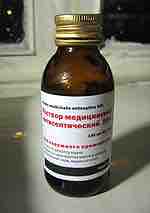Antiseptics are antimicrobial substances that are applied to living tissue/skin to reduce the possibility of infection, sepsis, or putrefaction. Antiseptics are generally distinguished from antibiotics by the latter's ability to be transported through the lymphatic system to destroy bacteria within the body, and from disinfectants, which destroy microorganisms found on non-living objects.
Some antiseptics are true germicides, capable of destroying microbes (bacteriocidal), while others are bacteriostatic and only prevent or inhibit their growth.
Antibacterials are antiseptics that have the proven ability to act against bacteria. Microbicides that destroy virus particles are called viricides or antivirals.
Most commonly used are ethanol (60–90%), 1-propanol (60–70%), and 2-propanol/isopropanol (70–80%) or mixtures of these alcohols . They are commonly referred to as "surgical alcohol. " They are used to disinfect the skin before injections are given, often along with iodine (tincture of iodine) or some cationic surfactants (benzalkonium chloride 0.05–0.5%, chlorhexidine 0.2–4.0%, or octenidine dihydrochloride 0.1–2.0%).

A bottle of ethanol (95%) - an antiseptic
A bottle of ethanol (95%) - an antiseptic
Quaternary ammonium compounds include the chemicals benzalkonium chloride (BAC), cetyl trimethylammonium bromide (CTMB), cetylpyridinium chloride (Cetrim, CPC), and benzethonium chloride (BZT). Benzalkonium chloride is used in some pre-operative skin disinfectants (conc. 0.05–0.5%) and antiseptic towels. The antimicrobial activity of Quats is inactivated by anionic surfactants, such as soaps. Related disinfectants include chlorhexidine and octenidine.
Boric acid: Used in suppositories to treat yeast infections of the vagina, in eyewashes, and as an antiviral to shorten the duration of cold sore attacks. Put into creams for burns. Also common in trace amounts in eye contact solution. A triarylmethane dye still widely used as 1% ethanol solution in Eastern Europe and ex-USSR countries for treatment of small wounds and abscesses. Efficient against gram-positive bacteria.
Chlorhexidine Gluconate: A biguanidine derivative, used in concentrations of 0.5–4.0% alone or in lower concentrations in combination with other compounds, such as alcohols. Used as a skin antiseptic and to treat inflammation of the gums (gingivitis). The microbicidal action is somewhat slow, but remanent. It is a cationic surfactant, similar to Quats.
Hydrogen peroxide: Used as a 6% (20 Vols) solution to clean and deodorize wounds and ulcers. More common 3% solutions of hydrogen peroxide have been used in household first aid for scrapes, etc. However, even this less potent form is no longer recommended for typical wound care because the strong oxidization causes scar formation and increases healing time. Gentle washing with mild soap and water or rinsing a scrape with sterile saline is a better practice.
Novel iodine antiseptics containing povidone-iodine (an iodophor, complex of povidone, a water-soluble polymer, with triiodide anions I3-, containing about 10% of active iodine) are far better tolerated, don't negatively affect wound healing, and leave a deposit of active iodine, thereby creating the so-called "remnant," or persistent, effect. The great advantage of iodine antiseptics is their wide scope of antimicrobial activity, killing all principal pathogens and, given enough time, even spores, which are considered to be the most difficult form of microorganisms to be inactivated by disinfectants and antiseptics.
Mercurochrome: Not recognized as safe and effective by the U.S. Food and Drug Administration (FDA) due to concerns about its mercury content. Other obsolete organomercury antiseptics include bis-(phenylmercuric) monohydrogenborate (Famosept).
Manuka Honey: Recognized by the U.S. Food and Drug Administration (FDA) as a medical device for use in wounds and burns. Active +15 is equal to a 15% solution of phenol.
Octenidine dihydrochloride: A cationic surfactant and bis-(dihydropyridinyl)-decane derivative, used in concentrations of 0.1–2.0%. It is similar in its action to the Quats, but is of somewhat broader spectrum of activity. Octenidine is currently increasingly used in continental Europe as a QAC's and chlorhexidine (with respect to its slow action and concerns about the carcinogenic impurity 4-chloroaniline) substitute in water- or alcohol-based skin, mucosa, and wound antiseptic. In aqueous formulations, it is often potentiated with addition of 2-phenoxyethanol.
Phenol is germicidal in strong solution, inhibitory in weaker ones. Used as a "scrub" for pre-operative hand cleansing. Used in the form of a powder as an antiseptic baby powder, where it is dusted onto the navel as it heals. Also used in mouthwashes and throat lozenges, where it has a painkilling effect as well as an antiseptic one. Example: TCP. Other phenolic antiseptics include historically important, but today rarely used (sometimes in dental surgery) thymol, today obsolete hexachlorophene, still used triclosan and sodium 3,5-dibromo-4-hydroxybenzenesulfonate (Dibromol).
Antimicrobial compound suitable for clinical use in critically colonized or infected acute and chronic wounds. The physicochemical action on the bacterial envelope prevents or impedes the development of resistant bacterial strains.